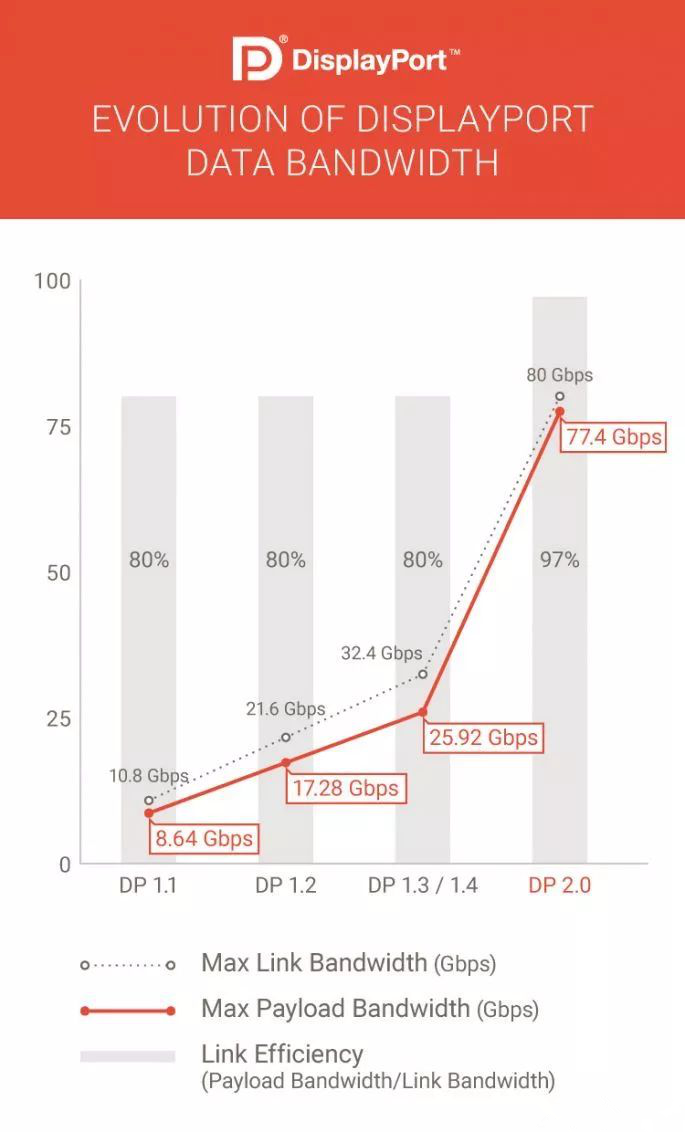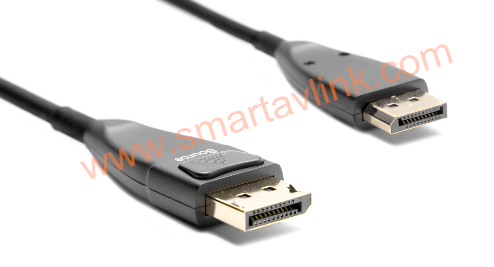On June 26, 2019, VESA announced the new DisplayPort 2.0 standard in San Jose, USA, offering a range of support for 8K resolution, high refresh rate 4K/HDR, and VR applications. compared to the 32.4Gbps (4lane x 8.1Gbps) bandwidth provided by the DP1.3/1.4 standard , the DP2.0 provides the same 80Gbps bandwidth as the Thunderbolt3. And DP2.0 adopts the new coding format, make the transmission efficiency from the DP1.1 to 1.4 era of 80% to 97%, resulting in a three-fold increase in the actual bandwidth of DP 1.3/1.4 25.92Gbps.

The huge bandwidth increases pave the way for future 8K, HDR and high-resolution displays beyond 8K, and standards also support multi-device displays, which are good for AR (augmented reality) and VR(virtual reality).
Compatibility
Although the DP2.0 is a significant change from the original DP1.4, the standard maintains consistent downward compatibility.
DP2.0 supports both traditional DP interfaces and the new TypeC interface, and still supports several key features of DP1.4a: Stream Display Compression (DSC) Forward Error Correction (FEC) , HDR metadata transport
Three times bandwidth than DP1.4
In the traditional DP1.4, the transfer rate per channel is 8.1Gbps, and due to the 8b10b encoding, the total bandwidth of DP1.4 is 4 x 8.1 x 0.8 =25.92Gbps. While the DP 2.0 of the Thunderbolt PHY has a transmission rate of 20Gbps per channel and uses a more efficient 128b132b encoding, the transmission efficiency is 97%, and the actual loan provided by DP2.0 is 4 x 20 x 128/132 =77.37Gbps ( Three times as much as DP1.4).
This means that DP2.0 is the first to support native, non-compressible 8K (7680 x 4320, 60Hz, RGB 4:4:4 30bpc) resolution.
Ultra-high-resolution display applications
Based on the bandwidth of 77.37Gbps, VESA provides us with several examples of applications with typical resolutions.
Single display device
16K resolution (15360 x 8460), 60Hz refresh rate, 30bpp, RGB 4:4:4 (DSC visual lossless compression) 10K resolution (10240 x 4320), 60Hz refresh rate, 24bpp, RGB 4:4:4 (no compression)
Dual display device
2 x 8K resolution (7680 x 4320), 120Hz refresh rate, 30bpp, RGB 4:4:4 HDR (DSC visual lossless compression) 2 x 4K resolution (3840 x 2160), 144Hz refresh rate, 24bpp, RGB 4:4:4 (no compression)
Three display devices
3 x 10K resolution (10240 x 4320), 60Hz refresh rate, 30bpp, RGB 4:4:4 HDR (DSC visual lossless compression) 3 x 4K resolution (3840 x 2160), 90Hz refresh rate, 30bpp, RGB 4:4:4 HDR (no compression)
DP2.0 can still provide support at 8K, 4K resolutions, even with a 2-lane USB-C DP Alt Mode.
3 x 4K resolution (3840×2160), 144Hz refresh rate, 30bpp, RGB 4:4:4 (DSC visual lossless compression) 2 x 4Kx4K resolution (4096×4096, AR/VR), 120Hz refresh rate, 30bpp, RGB 4:4:4 () DSC Vision Lossless Compression) 3 x QHD resolution (2560X1440), 120Hz refresh rate, 24bpp, RGB 4:4:4 (no compression) 1 x 8K resolution (7680×4320), 30Hz refresh rate, 30bpp, RGB 4:4:4 HDR (no compression)
Higher power efficiency
To improve power efficiency and reduce power consumption, DP2.0 introduced PSR (Panel Self Refresh), similar to the widely used in eDP, which enables new technology displays and GPUs to transmit only the changed parts of the picture, significantly reducing the power consumption of THE GPU and the display.
DP2.0 brings ultra-high bandwidth and coding efficiency that once again far exceeds HDMI standards, and we believe that the competition between DP and HDMI will continue in the future. However, the bandwidth of the DP2.0 80G also poses a higher challenge for the DP copper wire, believing that only the new optomebeop of the AOC (Active Optical Fiber Cable) can support a distance of more than 2 meters. Smartavlink has been working on DP2.0 and will provide 80Gbps DP 2.0 Active Optical Cable in the future, supporting 100 meters, helping users achieve applications of 5m to 100m in length. The image below shows a product photo of Smartavlink DP1.4 AOC :

